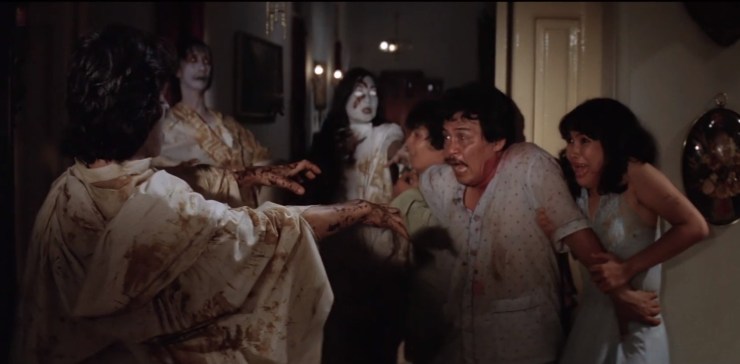Why Indonesian Horror Films ‘Satan’s Slave’ and Remake ‘Satan’s Slaves’ Should Be Watched Together on Shudder
In 2017, Satan’s Slaves topped the list of highest-grossing films in Indonesia. After receiving strong buzz during its festival run, the film found a perfect home on Shudder, where it’s continued its reputation as one of the streaming platform’s most frightening offerings. The international success of Satan’s Slaves seems fitting, considering it’s a remake of 1980’s Satan’s Slave, an influential entry in horror for Indonesia. Though it might’ve rocked the nation to its core upon release, Satan’s Slave proved to be a rare find elsewhere for decades. Until now, that is. Recently, Shudder made Satan’s Slave available to watch on their platform, serving up two distinct generations of vital Indonesian horror.
Touted as a remake of 1979’s Phantasm, 1980’s Satan’s Slave transformed Indonesian horror. Before its release, the genre was dominated by special effects-driven movies heavy on the gore. Satan’s Slave relied on eerie atmosphere and unsettling imagery. Directed by horror director Sisworo Gautama Putra, the film opens to a family in mourning. Mawarti succumbed to a mysterious illness, leaving behind her two children, Tomi and Rita, and husband Munarto. Munarto is mostly an absent father, preoccupied with work, and accumulating wealth. That leaves Rita struggling to figure out what’s happening with her younger brother Tomi, who insists the ghost of his mother is haunting him. Things get even stranger after the arrival of new housekeeper Darminah, an occultist woman with nefarious intentions.
Satan’s Slave goes to great lengths to show that this family’s life is devoid of religion, in turn making them susceptible to evil. They’re too occupied with the material or hedonistic things in life to practice. Rita enjoys disco parties and spending time with her boyfriend, Herman. It’s safe to assume mom Mawarti enjoyed the wealth provided by her workaholic and ambitious husband. Tomi seems interested in spirituality, but being left on his own without guidance means he’s prone to getting into trouble with his dabbling. Only the family’s sickly servant Mr. Karto is in tune with religion, though it can’t save him from the encroaching evil. Darminah systematically removes those closest to the family and uses them as undead slaves to wreak havoc. Only the help of a shaman and religion can spare them from becoming slaves of Satan.

It’s interesting to watch this film alongside its remake. To a modern audience, Satan’s Slave can read as camp, a product of its era. It’s clear that Sisworo Gautama Putra intended serious horror, though, and it proved massively effective on audiences in 1980. That includes Joko Anwar, who couldn’t get the film out of his head after being traumatized by fear in his first exposure to it—remaking a formative movie, the lifelong horror fan adhered to the essence of Satan’s Slave, the eerie atmosphere. While the original retained a simple good vs. evil plot, Anwar added complexity. In the remake, the death of the mother unleashes a curse birthed from a Satanic pact. How that unfolds proves far more complicated than before, but more importantly, it’s far scarier. Anwar employs every tool in his arsenal amassed from a lifelong affinity for the genre to deliver potent scares that come at a consistent pace.
Having access to Satan’s Slave on the same streaming platform as its remake doesn’t just work as an examination of cultural horror through generations. It provides the necessary context for the ending of Anwar’s film. Until this point, Satan’s Slaves offered a cryptic coda only insiders could interpret. In it, the surviving family members have fled their home and moved into a flat in the city. A neighbor brings them food before returning to her apartment, where she conspires with her partner to keep the family close. Their ill-intent makes it clear for any viewer that the family remains in danger, but it’s still a strange tease for a potential sequel. The mysterious woman’s lover then calls her by her name: Darminah. As in, the primary antagonist of the original film.

Applying the context of Satan’s Slave suddenly makes a seemingly benign ending to Satan’s Slaves more menacing. There’s now a face for the cult that tormented our protagonists. Being able to see the 1980 film expands on why this is an exciting tease for a sequel. Or at least, there’d better be a sequel. Thanks to streaming services like Shudder, or boutique labels like Severin (who’s releasing Satan’s Slave on Blu-ray soon), obscure horror films are being unearthed and made readily available to fans. It gives us a chance to see cinematic history on an international scale. In this case, it allows us to see how Indonesia loosely interpreted Phantasm, turned it into a groundbreaking horror film in its native country. Then that film inspired a modern retelling so successful at terrifying audiences that it’s ensured Joko Anwar is a genre filmmaker to watch on an international scale.
In terms of access to international horror, it’s a great time to be a fan.









